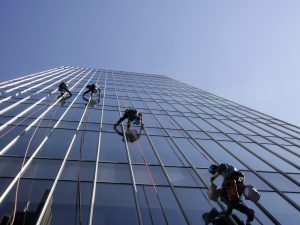Life is good when we get the quick fix! As children, our restless minds never want to work out the solution; just tell us the answer. Never mind how to get that answer. As adults, I’m not convinced our attitudes have changed much. Only the stakes have changed. We still strive for those easy answers, even if it is scaffolds or fall protection.
So goes fall protection for scaffold erectors. Give the erectors an easy solution and we don’t have to worry about the details. We don’t have to study the problem. We don’t have to gather the facts. We don’t have to work at the solution. We don’t have to recognize the laws of physics. In our search for the quick fix, we ignore the facts of the situation. We ignore the fact that fall protection for scaffold erectors is a very complex matter, not easily reduced to the quick fix.
Physics and engineering principles dictate the consequences of a fall and to achieve accurate results, we must consider all the forces that occur during a fall. The forces that develop due to a fall can be considered as either vertical or horizontal forces. The vertical forces are directed either up or down while the horizontal forces are directed either left, right, front, or back. The size, or magnitude, of these forces is basically determined by the height of the fall, that is how far the person falls before he or she is stopped. An example will demonstrate how the engineering principles are applied. Imagine that a scaffold erector is erecting a scaffold over a swimming pool. For some unknown reason, the erector falls, taking a dive off the scaffold platform into the swimming pool. I suppose it’s no big deal for the erector assuming there is sufficient water below and he is not tied to the scaffold. There are no substantial horizontal or vertical forces applied to the scaffold since he isn’t tied to the scaffold. The erector finds himself in the water and the scaffold remains standing. Let’s change the parameters a bit and you’ll see how things can change dramatically. Assume that we tied the erector to the scaffold because we don’t want him to get wet in case of a fall. When the erector takes a dive, he will be caught, after falling, by the lanyard that connects him to the scaffold. The erector may exert a horizontal force on the scaffold by pushing off, and the lanyard tied to the scaffold exerts both a vertical and a horizontal force due to the arc of the fall. Since nature likes everything in balance, there has to be a counteracting horizontal force and a counteracting vertical force. Depending on whether the scaffold is wide enough to act as a counterweight, or whether the scaffold is tied to a substantial structure, will determine if the horizontal forces are balanced. If we assume the scaffold is strong enough to support the vertical load of the erector and the fall, and the horizontal forces are balanced, the erector will remain suspended at the end of his rope. If the horizontal and vertical forces aren’t balanced, the erector will bring the scaffold down to the ground with him.
Substantial structures typically can provide substantial anchors. Conversely, non-substantial structures, such as scaffolds, can only provide non-substantial anchors. Keep in mind that laws based on the use of substantial anchors will not work for non-substantial anchors. In fact, standards written for construction workers exposed to falls from substantial structures may not work for scaffold erectors who want to use the scaffold as an anchor. It doesn’t get much simpler than that. The truth of the matter is that there is no quick fix.
Be careful though! Do not draw the conclusion that scaffolds cannot be fall protection anchors. Under the right circumstances, a scaffold can function as a suitable anchor. The trick is determining when that scaffold can be a suitable anchor. The current federal standards require that a qualified person determine a proper anchor because of the variables inherent in using a scaffold as a fall protection anchor. Sizable forces are generated when an individual falls off a scaffold. Depending on how the individual falls off the platform, or other scaffold member, will determine if both vertical forces and horizontal forces occur. Numerous tests have been done to show the adequacy, or inadequacy, of a scaffold to perform as an anchor. Since scaffolds typically can support vertical loads and forces well, a straight vertical drop can be easily resisted by the scaffold. Tests confirm this. However, once a horizontal force is introduced, things get complicated quickly. If the scaffold cannot resist these horizontal forces, the scaffold will fail. Tests also confirm this.
What does this tell us? First, don’t dive off scaffolds, especially if there is no water. Second, be sure you think about those horizontal forces. Fall protection tests on scaffolds may or may not include the horizontal force factor, depending on how the scaffold test is conducted. Scaffolds that are tall or massive may have sufficient counterbalancing weight while those scaffolds that are narrow or short, may not have sufficient counterbalancing weight. Therefore, the qualified person must consider a number of factors prior to using the scaffold for an anchor. More importantly, when conducting a test, or evaluating tests conducted by others, we must be careful that we aren’t too hasty in drawing conclusions. There is a very real danger in taking the results of one test and assuming it will work on all scaffolds, only to find that our assumptions are not only faulty but also pose a real hazard for the erector. Having said that, we must remember there is also danger in assuming that all scaffolds are inadequate anchors and erectors should never tie off.
The truth of the matter is that there is no quick fix. While scaffolds are versatile and adaptable, these attributes can also create complicated circumstances for fall protection. Technical solutions require technical tools and methods. We cannot ignore gravity nor can we ignore the laws of physics. We in the industry must recognize that realistic solutions will only come with realistic research, realistic analysis, and realistic expectations. To assume that there is a quick fix for fall hazards for scaffold erectors may result in a quick disaster. There is no quick fix.












